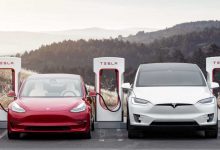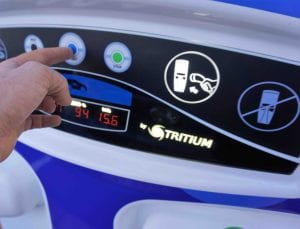The Tesla Model 3 electric car has half the impact of rival petrol and diesel vehicles in terms of carbon emissions over its entire lifecycle, and could achieve a fraction of the impact of a privately owned car when used as part of an autonomous “robo-taxi” fleet, says Tesla.
It is often falsely claimed that electric vehicles are worse for the environment because of emissions associated with the manufacture of batteries, or due to charging from coal-fired grids. The widely debunked Michael Moore documentary “Planet of the Humans” repeated those myths.
Tesla, in its 2019 impact report released this week, shows that its EVs produce far less carbon than internal combustion engine (ICE) vehicles, even when including emissions from manufacture and charging from fossil fuels.
The report, which compares energy consumption data from 4 billion miles (6.4 billion kilometres) driven by Tesla vehicles against real world consumption data from consumer advocacy site Consumer Reports, shows that not only are Tesla vehicles becoming more efficient over time, they will continue to do so.
It is Tesla’s plan for a “robotaxi” fleet which promises the most savings in terms of lifecycle emissions, revealing a key reasoning behind the EV and battery maker’s dual strategy to address both transport and energy generation and storage.
Using a “million-mile battery”, such as that expected to be revealed at Tesla’s upcoming battery day and which its Chinese battery partner CATL says it is now ready to make, Tesla would be able to dramatically reduce the carbon emissions per kilometre driven by its vehicles.
According to Tesla’s calculations, robotaxis provide the lowest emissions per mile, with zero use phase emissions assuming they are “used for ride-sharing over one million miles using cell chemistry from our energy products and it were only charged using a solar system and energy storage”.
“Such an effort dramatically reduces the lifetime carbon footprint of an EV, even when accounting for the carbon footprint of both the solar panel/Solar roof and Powerwall manufacturing,” the company states.
Unlike ICE vehicles which become less efficient over time unless subjected to a rigorous maintenance schedule, electric vehicles become more efficient as electricity grids transition to cleaner energy sources, the report says.
To read the full version of this story – and view the photo gallery – on RenewEconomy’s electric vehicle dedicated site, The Driven, click here…
RenewEconomy and its sister sites One Step Off The Grid and The Driven will continue to publish throughout the Covid-19 crisis, posting good news about technology and project development, and holding government, regulators and business to account. But as the conference market evaporates, and some advertisers pull in their budgets, readers can help by making a voluntary donation here to help ensure we can continue to offer the service free of charge and to as wide an audience as possible. Thankyou for your support.









